Dear Artist,
At the risk of beating a dead digital horse, I need to revisit something I wrote to you in last week’s letter. When discussing presenting art online, I mentioned that one might have more success attracting collectors by photographing something deemed precious in real life, as opposed to, say, a digital-only experience which could be difficult, in these times, to find a backer for. According to yesterday’s New York Times, I’m totally wrong. In 2021, it seems, some artists are having the greatest success selling completely digital art. This only-on-the-internet art is embedded with code that authenticates it, tracks its whereabouts and value, is transacted in cryptocurrency on the blockchain and can even be broken up into tiny pieces to be fractionally owned by multiple buyers. If you’re still with me, this new kind of art is called a “nonfungible token,” or NFT.
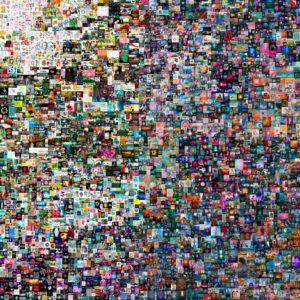
Everydays — The First 5000 Days, a collage of all the images that Beeple has been posting online each day since 2007, as presented by Christie’s:
token ID: 40913
wallet address: 0xc6b0562605D35eE710138402B878ffe6F2E23807
smart contract address: 0x2a46f2ffd99e19a89476e2f62270e0a35bbf0756
non-fungible token (jpg)
21,069 x 21,069 pixels (319,168,313 bytes)
Minted on 16 February 2021. This work is unique.
by Beeple (b.1981)
Yesterday, Mike Winkelman, the digital artist known as Beeple, with the help of Christie’s, sold a JPG for $69.3 million. In doing so, he beat Turner, Seurat and Goya’s auction records. He started off his one lot at $100 two weeks ago and watched it climb to $30 million. Then, with seconds remaining, his JPG surged to over $60 million in a frenzy. The newspapers, as part of their regular reporting on the cliquey, market-shaping investment habits of billionaires, noted that it was the third-highest auction result achieved by a living artist after Koons and Hockney. Apparently, in the highest-brow circles of art speculation, the only thing more exciting than snagging a real-life treasure to possibly hoard in an off-shore freeport is the record-breaking digital one you crypto-traded in bitcoin — the newest performance of wealth, even when democratized with fractional ownership — that can never be touched, smelled or installed.
If you’re wondering how we got here, I suppose this year, while the rest of us were reconnecting with the intimate, the performance gamblers among us would find ways to trade more stuff on the internet. It was only a matter of time before our most tangible experiences — art included — would be transformed into digital ones, and in doing so, be digitally monetized. Last month, Tesla invested $1.5 billion in bitcoin. After the hedge funds joined in, cryptocurrencies reached a valuation of over $1 trillion, taking with them crypto-traded NFT art. As a result, a fledgling handful of collectors trading NFTs in the $60,000 range last fall are now cashing in at over $6 million for the same piece. Today, NFTs are everything from performance pieces, videos, collages, social media posts, existing artworks that have been destroyed and appropriated, virtual collectible sneakers and collectible digital NBA highlight clips, the latter of which have reached $345 million in sales within the last month, plus JPGs, GIFs and even tweets; Jack Dorsey, the co-founder and CEO of Twitter is currently auctioning his first tweet, now NFT minted, for charity — the bid is currently $2.5 million. Lastly, 10,000 individual algorithm-designed characters, given away like digital baseball cards in 2017, were flipped for as much as $13,500 the following year, and one sold for $7.6 million on Wednesday, traded amongst those whom the blockchain literate have dubbed the “crypto-wealthy,” centered in Silicon Valley. It can all, it seems, be traced to Silicon Valley. The fact that they’re calling it art is, perhaps, just a convenient appellation. While digital art has been a part of our collective human creative endeavour for some time, its commodification needed an art world locked out of the fairs, galleries, museums and auction houses, suddenly forced to exist solely on the internet. Enter the greediest and savviest waiting there, and their new storefront is open for business.
Sincerely,
Sara
PS: “Art is no longer about a relationship with an object. It’s about making money. I feel bad for art.” (Sylvain Levy, art collector)
Esoterica: If you happen to have a bit of walking-around change and are thinking about some crypto art, you need to know that your NFT will never perfume your mansion with the ancient smell of linseed oil, gaze down on you raked with light on a Sunday morning or hint humbly, one day, for restoration. It will also never require photographing, crating, insuring and handling when you need to liquidate; its provenance will remain free of bunkers and palaces, and you won’t even have to patch a hole in your wall when it’s gone. Your NFT, rather than adding to your clutter and connecting you to the hand of its maker, will instead live as a commodity on the blockchain, perhaps changing accounts a few dozen times while the market’s still hot. Finally, when you need a write-off, consider donating it to the Museum of Contemporary Digital Art, which also exists solely online, to be catalogued there, to “preserve and archive the art of our time.”
Have you considered a Premium Artist Listing? With each letter, an artist is featured at the bottom of this page. The Premium Artist Listings are a means of connecting artist subscribers through their work. Proceeds from each listing contribute to the production of The Painter’s Keys.
“The only reward one should offer an artist is to buy his work.” (Pierre-Auguste Renoir)
Featured Artist
The move to Northern California spurred my desire to paint the landscape – motivated in part by the fear that I would wake up one day and it would all be gone! I had some kind of doomsday concern, tantamount to extreme climate change or bombs going off like Hiroshima —something drastic.
The Wildfires of 2017 were traumatic, we experienced three on our land that year.
In processing the fire experiences and living with the constant awareness that what happened then can happen again. I produced a short film entitled:: From the Ashes – Fire, Survival. and Renewal, about how our community responded to the Redwood Complex Fire 2017.The is film available for free screenings to community fire councils and art institutions. I am working on part two.
In 2020, largely due to the ensuing California wildfires, we chose to sell our 195 acre place and move back to the East Coast, where our families live and we are creating a new life and farm.
I am still witnessing and interpreting the landscape.
Jaye Alison Moscariello

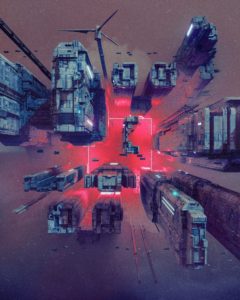
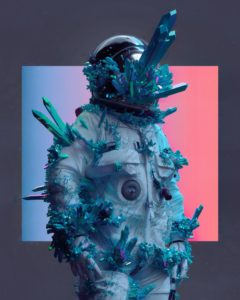

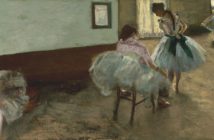
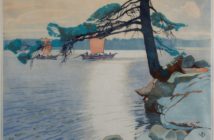
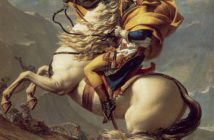
68 Comments
This post makes me feel nauseated. Not your writing, Sara, which is wonderful as always. Rather, the concept about which you write. It underlines and highlights the absolute irrelevance of money. If we are putting our money into virtual sneakers, then money has lost its relevance in this world. Perhaps now love or caring or kindness can become the real currency.
So, what happens to this “art” when the electricity fails and internet connections fail along with it? Thanks, but I think I will continue to make actual art with a presence in the real world. I like something I can hold in my hand or hang on my wall…
Exactly: what happens when the power grid goes down?
Nothing. It just sits there waiting for the power to be restored.
Glenn, wouldn’t that be as long as no one runs off with the server that hosts it? (e.g. wasn’t it Mt. Gox where the bitcoins became unaccessible?)
I feel the same way but what happens in a huge storm Katrina,etc style or CA fires? According to Quantum Physics, isn’t it all an illusion? Mother Nature is all potential. I think this is one good reason old people die so experimenting can thrive. This is my latest conclusion as an old person.
I can barely wrap my head around this trend of digital, high dollar “work”. My heart stays with family, friends, and community artwork, where I know their history and efforts. I value soul!
I can hardly begin to understand how it works. I will never buy into the concept so it doesn’t really matter.
Keep painting !
How utterly and devastatingly depressing. I didn’t understand one word and don’t care to.
Ugh
Fascinating!
My husband and I are in the process of moving. How silly of us to have a collection of original artwork, accumulated over several decades, which we have to carefully pack and pay to have moved to our new home! Instead, we could just have digital so-called “art,” stick a tiny thumb drive in a pocket. Then in our new house, we could have multiple iPads and or monitors on our walls. How cozy! Or we could just have blank walls and view our collection on our phones. If this is the future, I’m glad I’m getting old.
Caroline, I was thinking the same thing – I have some ancient pieces my great-great grandfather collected – at one time valuable, but now not in vogue – thus little value. We just love to look at them. It is an interesting thought, that given enough time with LED screens/iPads on walls, tangible art may be a valued trend again …. !
So how do I make this digital art?
With a computer. And a Bitcoin account. Then find a site such as Rarible.com to sell on.
Thanks Glen.
Very helpful post .. I am a lifelong painter but I’d like to try it.
There’s no point getting grumpy and comparing it to an art object
This is a completely new and different world for people who live and find their creative pleasure online.
Roberta, I have a very long post on my experience with it.It’s not posted here yet because of moderation.. I’m not an expert but did it! Perhaps I should write up a page and make it available on my website. The art on the various sites is in my opinion, POOR. Some sites like Makers Place and Known Origin are by invitation only and the quality is higher. Thus, I would never get in there! I uploaded at opensea.io. I think traditional artists and galleries can UTILIZE the markets. Or have their own private ones. Truly, if you wanted to mint art on one of the marketplaces, you can sell it and indicate in the description that you can physically mail it. The problem comes in with subsequent sales not having control to make sure it physically changes hands. Additionally, you can set the amount you want to recieve on those subsequent transactions. I think 10% ot 15% is typical. So, that would benefit artist tremendously especially if they turn into a David Hockney or Jeff Coons!
Hi Lynn,
Simply, grab a graphics tablet, a stylus and 2 or 3 painting apps. Most are free or cheap. Ecperiment with stylists’ before buying. The SPen from Samaung is nice. Apple has the Apple Pencil. For those with more cash, Wacom tablets might work. Best Buy has products on display. And they love to talk about tablets and graphics.
iPad Pro for ppl that like Apple, Samsung for those who like Android, and Surface products for those who prefer Windows.
For beginners, apps include Sketchbook Pro by Autodesk, Infinite Painter, Corel Mobile can be used on Android OS. Sketchbook has apps for all 3 platforms.
Procreate is top of the list for Apple, though Infinite Painter has and app for iOS as well.
Serif products offer (3) apps…Photo, Design and Publisher which can be purchased outright without subscription and rival the likes of Adobe products.
Its great fun! And tons of art can be done without harming the environment, buying lots of paint, canvas, media and medium. It can be shared immediately, printed, painted on, its quite incredible.
Have fun!
Lynn, You can find many videos online of how to use various programs. ArtProf has videos on Procreate and recently Fresco.
I’ve started using my iPad Pro and pen with Adobe’s Fresco. Sketchbook Pro app is also a favorite…
Honestly, where some make sketches, I’ve always used my iPad to work out ideas and then try to paint them. Or, sometimes I just like them. I used layers in Photoshop to convert my iPad drawing into different images to use for the different woodblocks on a woodblock print.
I know of a local artist, I took his Photoshop class for artist, that actually constructs his own image (made of photos) for painting. He moves things, adds things, for composition.
I love playing around and David Hockney said there is no greater medium for instant application of color!
Reminiscent of “tulip mania” in the 1600s in Holland. I prefer to live in the real world.
What nonsense! I’m staying old school.
your article doesn’t surprise me. I’m not hung up on the rightness or wrongness of the digital art and if an artist can make money doing it….more power to them. I wish I knew how to. Being a retired goldsmith I saw CAD systems and robots take over the jewellery making process. It didn’t totally wipe out the art form but it sure put a dent into it. There were other factors as well…..tattooing became the desired form of self adornment. Tattoo parlors have replaced jewellery stores just like the car replaced the horse and buggy. It’s just evolution. I personally believe art is everything and can be found everywhere. In our modern digitized world this is the most popular art form of the day.
I was/am one of those putting a dent in the jewellery making world. Using 3D modeling programmes such as Rhino and ZBrush, along with an online 3D Printing company I was able to build up a nice paying hobby designing in many materials from plastics through gold and silver to titanium. True jewellery makers will never disappear. The field just opened up to allow more access and diversity. Just as digital art has done.
And Glenn, I read that even a chisel and rock tablet still has a place in our society! Gravestones!
Agreed sadly
The investing habits of the unruly rich are indeed a mystery. The work they buy might not be half bad– in fact it might be good– but the prices are ridiculous. Until those fortunes are under reasonable control — and who knows what that means — using prices to gauge artistic merit would be ridiculous.
Trust me – there is an absolute TON of bad art dominating the NFT world. Imagine early 90’s computer graphics having been thrown up into a blender and then someone removing the lid halfway through the process. That’ll give you an idea.
This is an investment scheme of financial manipulation under the guise of art. Thank you Painter’s Key for always presenting new ideas for us to ponder & keep us grounded as well as up to date.
As always: there’s a sucker born every minute.
Fascinating on one level, and every artist needs to know this is happening, whether we like it or not.
NFTs also remind me of the tulip bulb craze in the Netherlands centuries ago, and BeanieBabies a few decades ago…and we all know how those ended up.
I think this new market for digital art, again, is for the upper-echelon of the ‘art world’. That is, mere mortals like myself who sell commercially but not at this level, will never have entrance into this realm, just like I highly doubt I’ll be showing in any brick and mortar blue chip art galleries this lifetime. I believe there will always be a market for billionaires to spread their monies around in the subjective and unregulated art markets and this is just another opportunity for a wealth-grab, saying nothing about the hard-won triumphs of showing up daily and getting on with ones work in the studio. In my view, the tangibility of physical art works will always be valued for what they are and I believe there will always be a market for them.
Since I’ve commented on so many of your posts…I’ll summarize it here. I’m no expert and I just have experience as I’ve played with it. I’m not a pro artist either. I just dabble.
I think the block-chain underlying cryptocurrency will become more widely used for all sorts of things. There’s a public record of transactions.
NFTs are based on one of those currencies, Ethereum. The mining (processing and creating coins, the ledger, etc) utilizes tremendous amounts of energy. A change is coming for Ethereum and will utilize staking rather than minting. It will have far less environmental impact.
You can mint a photo of anything. So, you CAN sell traditional art there.
I think it could be used for Provenance. Once an artist puts art there, they’ve “minted” it. It’s theirs.
Subsequent sales provide the artist a percentage that they specify.
I see where a gallery could run a private server (and all transactions could be private), but transactions are recorded on the block-chain – that public ledger.
It’s really just evolution and it’s moving very fast now. It will eventually be just a common as iPads/Phone.
I’m pretty sure it will never replace traditional art. But, young folks are less adverse and may just have monitors on their walls and all over the place. I read Bill Gates had that. He also has lots of real art.
Don’t fear, it’s just a natural occurrence and I think it will assist traditional art, not replace it.
Much of the pleasure of painting is act of applying paint to a surface with a brush.
Yes!
Thank you, Sara, for writing about this. It’s good to revisit and question our practice as artists and why we create art. To me, it still comes down to what I want to express and what medium expresses it fluently, regardless of hype and gilded promises. I feel it’s important to stay grounded in the real world and play with my smelly, messy art supplies. As always, collectors buy art for their personal enjoyment and/or as commodity. Nothing new, except for the currency.
ART AS COMMODITY: I don’t make dice for anyone’s crapshoot.
If Art is everything, Art is Nothing,
This nonsense too, shall pass.
Keep painting.
Omg…I’m sorry, I enjoy technology and all, but it’s been becoming cult-like for awhile now.
Thank you for this timely article. As the press marvels at the obscene amount of money NFTs are fetching, often there’s no mention of the huge carbon footprint of cryptocurrency and the blockchain NFTs require. It’s all quite mind bending. My artwork is 90% digital and offered as limited edition prints. When I learned an artist I admired “dropping” works on Nifty Gateway my interest was piqued. I’m happy digital artists are being rewarded, but the environmental cost is not acceptable for me. It’s a gold rush right now, speculation and greed are fueling the fire. Everest Pipkin explains it here https://everestpipkin.medium.com/but-the-environmental-issues-with-cryptoart-1128ef72e6a3
Thank you for this link, Leslie. Fascinating, educational read. I would urge everyone who is expressing an interest in crypto art to read this first! Sure dissuaded me quickly!
my mind is blown…don’t know if I want to laugh or cry. The absurdity of it all. Thank you Sara for this really interesting article and Leslie for attaching the link that filled in the gaps for me.
Truly, this article linked, says it all. Wasted materialism and excessive consumerism.
NFT’s are gamblers chips. Commodities that spend excessive energy – ie adding to the planet’s energy consumption which supports only the ones with deep pockets, regardless of side effects on the earth.
Art, truly, is from the heart, from inspiration, from another source that cannot be bought and sold in digital. This link is key.
Life needs to be more harmonic with this planet. If we practice tangible art, from true inspiration, this is a gift in itself. Bringing joy to others, enriching lives by the beauty of art and music. This is culture enriching people. Bringing rewards of many kinds. Art, music, beauty, essentials to living well.
Such a connection in South Korea, bringing people to art fairs and studios, is what turned their economy around. With tangible art. The importance of culture, art and music, is essential, specially in hard times.
It seems like it is another way to launder money. No reflection on the art, this one is pretty appealing as I’m sure others are. Good for digital artists to have a truly digital market. It will not change how I make art.
You are right…Some of the disclaimers when you sign up for an account address money laundering… I do think traditional galleries and artists can utilize this technology for their benefit.
PS: “Art is no longer about a relationship with an object. It’s about making money. I feel bad for art.” (Sylvain Levy, art collector)
I AGREE.
I do remember seeing a show of David Hockney’s work several year’s ago in NYC and it was walls full of big tablets of his digital work. Doesn’t do it for me, but I guess to each their own.
I wonder, were all the works collaged together his own? Did he borrow/take other artists’ work and did he pay for them? If he didn’t, then there is a copyright issue here, I believe. But then, maybe he created these 5000 pieces of digital art himself There is a huge variety of styles here, however. Just wonderin’.
I do believe they are his own. He created one a day for 5k days. He’s a computer scientist and a story was on PBS Newshour about him last night.
As a person who has spent more than 50 years in the computing business I don’t think that the purchasers of this type of art have anything going for them. The idea that this is a permanent work of art is not likely to be true. It is only as permanent as the technology on which it is stored. I have seen at least 10 types of storage become obsolete and not be accesable any longer. Also, the NFT, being computer code can be altered by a truly knowledgable computer geek even if it is encrypted.
Dan,
I think the underlying technology will become used in all sorts of arenas because of the public ledger. Current IRL (in real life) artists can use it and simply mail the artwork. You can list it and sell it on the exchange and take a percentage of all subsequent sells. I think galleries should create their own private marketplaces on the blockchain. Provenance would be there.
NFT—-No F***ing Talent
If a banana on a wall can sell for thousands as legitimate art, then NFT is but another “progressive” move to furthering con art; con as in mockery and fraud, not as in contemporary.
An interesting aspect of NFTs is a portion of each subsequent sale goes to the artist. “Droit de suit” rises from its graveyard to inhabit the blockchain.
As a person who has and still does photography, digital art and painting, with a lot of cross pollination, I see this as as a positive. I have had immense difficulty in monetising my work. I have been able to exhibit in the USA in 31 states with lots of overlaps, But these college and community galleries aree not geared for sales. In Canada I can exhibit in in local open, no restiction shows, but that is a dead end.
American curators were way more open to accepting digital art, Canadian curators a dismal few.
I think the negative response to NFTs or anything digital is built into the Canadian psyche that can’t see digital as valid a means for self expression as a a pen, pencil or brush.
Thanks for the post
Raymond St Arnaud
Victoria BC
Hi Raymond, I also create most of my artwork using digital tools and agree it’s very difficult to monetize digitally created artwork , as I write in my comment above… the environmental cost is not acceptable for me. It’s a gold rush right now, speculation and greed are fueling the fire. Everest Pipkin explains it here https://everestpipkin.medium.com/but-the-environmental-issues-with-cryptoart-1128ef72e6a3
Leslie,
Regarding the environment, they are well aware and a change is coming to the Ethereum coin. Here’s an article. But basically (I think) minting/mining is replaced by something called staking. I’ve heard it will render the large mining farms unneeded. It just so happens that NFTs use that coin, Ethereum.
https://ethereum.org/en/eth2/
Raymond,
If you want my story of how I got NFTs minted, write me at mpratt@northerneasel.com I will share what I know and help you get your work up there. First, since it seems you must be a pro artist, I recommend you try to get accepted here: https://makersplace.com/creators/ They are restrictive. I could never get in. There are a few sites like that. Their quality is higher and I think many artist on there are pros.
I will share what I did regarding Ethereum, bitcoin wallets, etc…It’s a very long post I made on one of the comments here. But it is so long it didn’t post because it is moderated and it may be too long to post here!
I’ve seen some of the NFT’s, I don’t like them. I too thought of tulip bulbs and that level of art has little to do with art and everything to do with creating hype to create a value for investment.
Pat, I don’t like many of them either! However, I did stumble across a site? maybe Makers Place. On there I found a young artist with a BFA from ? some very good east coast school. He works at the Met and I loved his digital art. He’s on one of the sites. So there are sites, just like galleries, that host only higher quality art.
I love ya Sarah but you wasted a crap load of letters writing on this crap… heard it today too and was just sad,
there’s no accounting for the knuckleheads of this world.
Wait. What?
The beauty that actual pigments bring to canvas from someone’s heart and hand still has the most value to me.
As for collecting/trading digital coins or crypto art…for those that like “virtual wares” I guess it has limitless value and is rather a creative way to “collect” in this digital age. The sky’s the limit it seems… Or should I say the “Cloud?”
Today I walked in the physical with a new painting to the gallery that represents my work. By surprise, a painting of mine ( the same size) had just sold to a couple who were still there and I was able to meet them in the physical, 6 feet apart, but in the physical. I was told how thrilled they are to own a painting that they loved and they looked forward to seeing it in their home. And, the new one I brought down was put in the spot that the sold one left vacant. May not be an experience that turns into zillions in silicone valley, but it lifted my soul and made me so very thankful for what I do as an artist. I want nothing more from this confusing and tiring occupation that consumes me, it is all more than enough, and a constant reminder of how lucky I am.
There is very strong feeling about this absurdity and rightly so. It in indicative of the very sad and dangerous state of the world we live in where life is being snatched away in the stupid pursuit of “money”, something that is itself a dead thing and so can be wholly possessed. There is on this side of the Atlantic an artist movement called “Culture declares emergency.” It is an organisation that recognises that the world is in pearl and that as cultural agents we can take responsibility and action to try and bring about the deep and systemic change needed in the world today. “EVERYTHING MUST CHANGE.” As artists, we have creative power, a potent means of communication and public platform. We are not powerless and we are not mute. Last summer I did an online course on eco-literacy specifically designed for artists and creatives in the cultural sector designed and hosted by artist scientist Dr. Cathy Fitzgerald. She has created an online learning platform called “HUMEA eco-literacy for the arts” to address a vital knowledge gap for artists to help empower them with eco-literacy skills and a support network to take up the challenge of real cultural change. The human species has been put under a spell and is walking blindly towards the abyss. For the love of life, what are we going to do about it?
Fake Art. Fake Money. Fake Lives.
This (digital art monetization) is all news to me, but our collective outrage could easily be transported to other century’s responses to Impressionism, Cubism, or Pop Art – just for starters. Part of our job as artists is to explore new ways to express the reality (or unreality ) of being, so I for one must hand them the Mind Blower award of 2021.
Personally, however, I will continue to push my ‘tangible’ painting practice toward simpler goals. My greatest success was confided to me by one of my collectors – in the midst of this Pandemic – that every day she does the same thing. She gets up, gets dressed, makes the bed, goes downstairs. Then she sees my painting on her living room wall, and she is overwhelmed with joy – every time, every day.
So happy I read your post. The article left me feeling depressed but this is a reminder that the paintings one can look at each day, in different light give a multitude of experiences.
As someone who has always had a technology bent and likes traditional fine art, I’m a little beyond many artists in terms of where they reside on the issue of NFTs and digital art as I’ve thought about it longer. Here I will share my experience and thoughts.
I started playing with trading bitcoin a few years ago and could only afford to buy into Ethereum. To trade on the Coinbase Exchange (not the coinbase wallet) you must trade .1% and I wasn’t willing to spend more than $25. So, I bought and sold and bought and sold and worked it up to well over $100. I didn’t think it was a bad return. But, you deal in up to eight decimal points and honestly I got tired of tracking it on a spreadsheet to pay capital gains to the IRS. So, I left if alone for two or three years and now it’s worth over $500. Don’t lose your password is what I’ve learned (and I haven’t).
This January I read an article about NFTs in The Art Newspaper from UK. I had already been playing with art created with subsets of Artificial Intelligence, neural style transfer and deep dream. Years ago I added this page to my website about the transfer of style — https://www.northerneasel.com/machine-learning
Once I figured out the type art sold as NFTs, I thought my landscape art fits in nowhere. But there are AI-created images…So, I kept looking and found opensea.io where you can actually upload art without a cost. You must get another wallet (metamask). I uploaded it and once I wanted to sell it, I had to pay gas. So I added $$s (I created a bank account at my credit union that is ONLY used on internet accounts) at my coinbase wallet which required ID to signup and is actually connected to that bank account (coinbase.com) and I sent money to the new wallet. Each has a long cryptic address that you copy and send and if you get the address wrong it’s lost forever. I created a collection on OpenSea.io . Only when I wanted to sell it did it cost. And when I clicked “sell now” I could see the size of the image and the time changed the price). So, to start the collection (once started no other costs for the collection), I uploaded a smaller 300 dpi image. I think I got it started for around $70. I just kept clicking “sell now” to see the current cost and at one point it would have been over $200 all in the course of an hour. Demand affects the price. Funny when I wasn’t willing to lose more than $25 starting out. So, the collection is started and adding to it has no cost. However, I thought I would put one up for auction and that would be a different collection and cost apparently. So, no auction.
I’m just figuring it all out. Here’s my collection: https://opensea.io/collection/ai-art-by-northerneasel
Back to more about Coinbase Exchange. My broker tells me the place I traded, pro.coinbase.com, looks just like the NASDAQ exchange. Maker orders used to have no cost/fees. Now it appears they may. I have Ethereum sitting there. But, trading it again looks like it would be expensive to get back in as it just keeps rising, so I let it ride.
How is it much different than our stock exchange? With the out-of-whack PE ratios, not much. It’s a bit of a figment and people trade on ether in either situation. Buy low and sell high. Young people have no fear of bitcoin. And it’s the silicon valley entrepreneurs driving this craze.
I don’t think digital will replace traditional art, and I think traditional art can actually use it to a benefit. Imagine a server controlled and run by a gallery (like a private opensea.io or rareible). Artists can register their art there and select buyers (by invitation) can buy art. The provenance will be “publically” traceable on the blockchain. But on the private server, no one can see who was involved. And once you’ve registered something, it’s yours. Sort of like Copywrite, registered and all transactions subsequent are logged. You can take photos of traditional art and register it. You can do that now on opensea.io and if you never try to sell it on their exchange, there is no cost.
I see lots of work to do on the blockchain. A change is coming for Ethereum (all these type of coins are run on different servers) that will prevent so much energy use (the minting and logging costs) and will eliminate gas cost. Oh and we could all create our own coin. I think a server is all that’s needed. Here’s a funny story related to that…The history of Dogecoin and Elon Musk. https://decrypt.co/61293/elon-musk-wants-coinbase-to-list-dogecoin
Anyway…I thought I’d share what little I know as I’m sure more artists are interested in NFTs.
I’m not a professional artist, but once I retire in a few years, I plan to call myself one and I’m just learning about what’s required and playing with it. I won a free website review and that’s the only reason my site looks as good as it does.
Happy Painting, Marcia
Thanks Marcia, but I still find you’re speaking Greek. Will have to study this a bit more (no pun intended) from a more basic level, to understand what you are talking about….
For amazing digital art, check out Alexis Franklin. You can click on a piece of her art and see a video of it being created. And she is only 24! A master. Beeple…ehh.